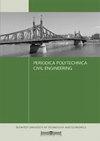The Influence of Brittleness of Interlayers on the Failure Behavior of Bedding Rock; Experimental Test and Particle Flow Code Simulation
IF 1.4
4区 工程技术
Q3 ENGINEERING, CIVIL
引用次数: 0
Abstract
In the present study, the effects of angle and brittleness of interlayers on the shear failure behavior of notched bedding rock have been scrutinized using experimental shear tests and particle flow code (PFC) simulation. Notched bedding models with dimensions of 20 cm × 24 cm × 5 cm containing soft interlayer and hard interlayer were prepared. The ratio of compressive strength to tensile strength in soft gypsum and hard gypsum are 12 and 7.8, respectively. The layer angel changed from 0° to 90° with an increment of 15°. The lengths of notches in each model are similar and were equal to 20 mm, 40 mm, and 60 mm. Models were tested by Punch shear by displacement loading rates of 0.05 mm/min. Results showed that pure tensile fracture was developed from the tip of the notch, and propagated in the direction of the shear loading axis till coalescence with the model boundary. Whereas soft brittle gypsum has less deformability in comparison to hard ductile gypsum therefore the continuity of shear displacement associated with crack growth in soft interlayer was less than that in hard interlayer. Also, soft brittle gypsum has less shear strength in comparison to hard ductile gypsum therefore the shear strength of bedding rock has maximum value when hard ductile gypsum was occupied more percentage of shear surfaces. The failure mechanism was alike in both the numerical simulation and the experimental test.夹层脆性对顺层岩石破坏行为的影响实验测试和粒子流模拟代码
本文采用实验剪切试验和颗粒流程序(PFC)模拟研究了夹层角度和脆性对缺口层理岩石剪切破坏行为的影响。制备了尺寸为20 cm × 24 cm × 5 cm、含软夹层和硬夹层的缺口层理模型。软石膏和硬石膏的抗压强度与抗拉强度之比分别为12和7.8。层角从0°变为90°,增量为15°。每个型号的缺口长度相似,分别为20mm、40mm和60mm。以0.05 mm/min的位移加载速率对模型进行冲剪试验。结果表明:纯拉伸断裂从缺口尖端开始,沿剪切加载轴方向扩展,直至与模型边界合并;而软脆石膏的变形能力比硬韧性石膏小,因此软质夹层中与裂纹扩展相关的剪切位移的连续性小于硬质夹层。软脆石膏的抗剪强度小于硬延性石膏,因此当硬延性石膏在剪切面中所占比例较大时,顺层岩的抗剪强度最大。数值模拟结果与试验结果的破坏机理一致。
本文章由计算机程序翻译,如有差异,请以英文原文为准。
求助全文
约1分钟内获得全文
求助全文
来源期刊

Periodica Polytechnica-Civil Engineering
工程技术-工程:土木
CiteScore
3.40
自引率
16.70%
发文量
89
审稿时长
12 months
期刊介绍:
Periodica Polytechnica Civil Engineering is a peer reviewed scientific journal published by the Faculty of Civil Engineering of the Budapest University of Technology and Economics. It was founded in 1957. Publication frequency: quarterly.
Periodica Polytechnica Civil Engineering publishes both research and application oriented papers, in the area of civil engineering.
The main scope of the journal is to publish original research articles in the wide field of civil engineering, including geodesy and surveying, construction materials and engineering geology, photogrammetry and geoinformatics, geotechnics, structural engineering, architectural engineering, structural mechanics, highway and railway engineering, hydraulic and water resources engineering, sanitary and environmental engineering, engineering optimisation and history of civil engineering. The journal is abstracted by several international databases, see the main page.
 求助内容:
求助内容: 应助结果提醒方式:
应助结果提醒方式:


